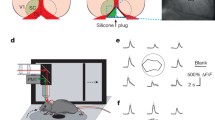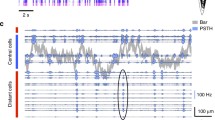Summary
By recording antidromic field potentials and unit responses generated in the retina by stimulation of the optic tract and optic disc, evidence was obtained which suggests the presence of four major conduction velocity groups in the cat's optic nerve. The axons from all peripheral retina appear to fall into two groups, fast and slow, which correspond to the two major velocity groups described by earlier workers. Evidence is presented that the axons which arise from the area centralis form two distinctly slower conduction velocity groups. For each conduction velocity group, and for 60 single units, conduction velocity was estimated for both the intraretinal (unmyelinated) and extraretinal (myelinated) segments of the axons. All axons encountered accelerated markedly on leaving the retina. An anatomical basis for the classification of conduction velocity groups is presented in an accompanying paper.
Similar content being viewed by others
References
Bishop, G.H., Clare, M.H., Landau, W.M.: Further analysis of fibre groups in the optic tract of the cat. Exp. Neurol. 24, 386–399 (1969).
Bishop, P.O., Jeremy, D., Lance, J.W.: The optic nerve. Properties of a central tract. J. Physiol. (Lond.) 121, 149–152 (1953).
—, Kozak, W.R., Vakkur, G.J.: Some quantitative aspects of the cat's eye: axis and plane of reference, visual field co-ordinates and optics. J. Physiol. (Lond.) 163, 466–502 (1962).
Brown, K.T.: Optical stimulator, microelectrode advance and associated equipment for intraretinal neurophysiology in closed mammalian eyes. J. Opt. Soc. Amer. 54, 101–109 (1964).
Chang, H.T.: Fiber groups in primary optic pathway of cat. J. Neurophysiol. 19, 224–231 (1956).
Clare, M.H., Landau, W.M., Bishop, G.H.: The relationship of optic nerve fiber groups activated by electrical stimulation to the consequent central post-synaptic events. Exp. Neurol. 24, 400–420 (1969).
Dodt, E.: Geschwindigkeit der Nervenleitung innerhalb der Netzhaut. Experientia (Basel) 12, 34 (1956).
Fukada, Y., Motokawa, K., Norton, A.C., Tasaki, K.: Functional significance of conduction velocity in the transfer of flicker information in the optic nerve of the cat. J. Neurophysiol. 29, 698–714 (1966).
Gouras, P.: Antidromic responses of orthodromically identified ganglion cells in monkey retina. J. Physiol. (Lond.) 204, 407–419 (1969).
Granit, R.: Centrifugal and antidromic effects on ganglion cells of retina. J. Neurophysiol. 18, 388–411 (1955).
Hodgkin, A.L.: A note on conduction velocity. J. Physiol. (Lond.) 125, 221–224 (1954).
Hursh, J.B.: Conduction velocity and diameter of nerve fibers. Amer. J. Physiol. 127, 131–139 (1939).
Katz, B.: Nerve, Muscle and Synapse. McGraw-Hill (1966).
Lennox, M.A.: Single fibre responses to electrical stimulation in cat's optic tract. J. Neurophysiol. 20, 62–69 (1957).
Motokawa, K., Oikawa, T., Tasaki, K.: Studies of neuronal processes in the retina by antidromic stimulation. Jap. J. Physiol. 7, 119–131 (1957).
Ogawa, T., Imazawa, Y., Chu, S.: Electrophysiological tracings of intraretinal optic nerve fibres in the cat. Tohoku J. exp. Med. 98, 215–222 (1969).
Rodieck, R.W., Pettigrew, J.D., Bishop, P.O., Nikara, T.: Residual eye movements in receptive-field studies of paralyzed cats. Vision Res. 7, 107–110 (1967).
Rushton, W.A.H.: A theory of the effects of fibre size in medullated nerve. J. Physiol. (Lond.) 115, 101–122 (1951).
Spehlmann, R.: Compound action potentials of cat optic nerve produced by stimulation of optic tracts and of optic nerve. Exp. Neurol. 19, 156–165 (1967).
Stone, J.: A quantitative analysis of the distribution of ganglion cells in the cat's retina. J. comp. Neurol. 124, 337–352 (1965).
—, Hollander, H.: Optic nerve axon diameters measured in the cat's retina: some functional considerations. Exp. Brain Res. 13, 498–503 (1971).
Sumitomo, I., Ide, K., Iwama, K.: Conduction velocity of rat optic nerve fibers. Brain Res. 12, 261–264 (1969).
—, Arikuni, T.: Conduction velocity of optic nerve fibers innervating lateral geniculate body and superior colliculus in the rat. Exp. Neurol. 25, 378–392 (1969).
—, Iwama, K., Arikuni, T.: A relationship between visual field representation of rat lateral geniculate cells and conduction velocities of optic nerve fibers innervating them. Brain Res. 24, 333–335 (1970).
Takahashi, K.: Slow and fast groups of pyramidal tract cells and their respective membrane properties. J. Neurophysiol. 28, 908–924 (1965).
Author information
Authors and Affiliations
Rights and permissions
About this article
Cite this article
Stone, J., Freeman, R.B. Conduction velocity groups in the cat's optic nerve classified according to their retinal origin. Exp Brain Res 13, 489–497 (1971). https://doi.org/10.1007/BF00234279
Received:
Issue Date:
DOI: https://doi.org/10.1007/BF00234279




